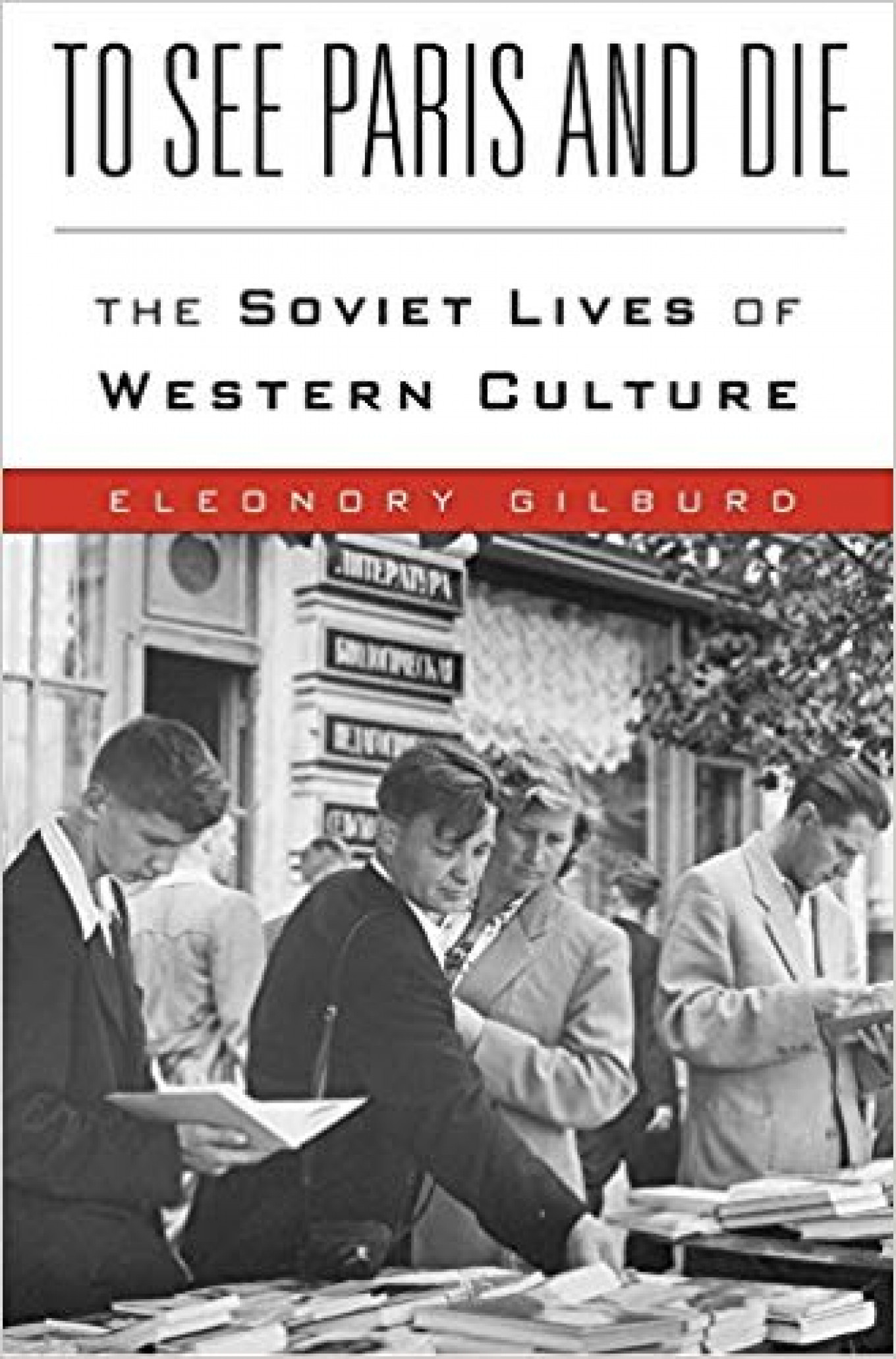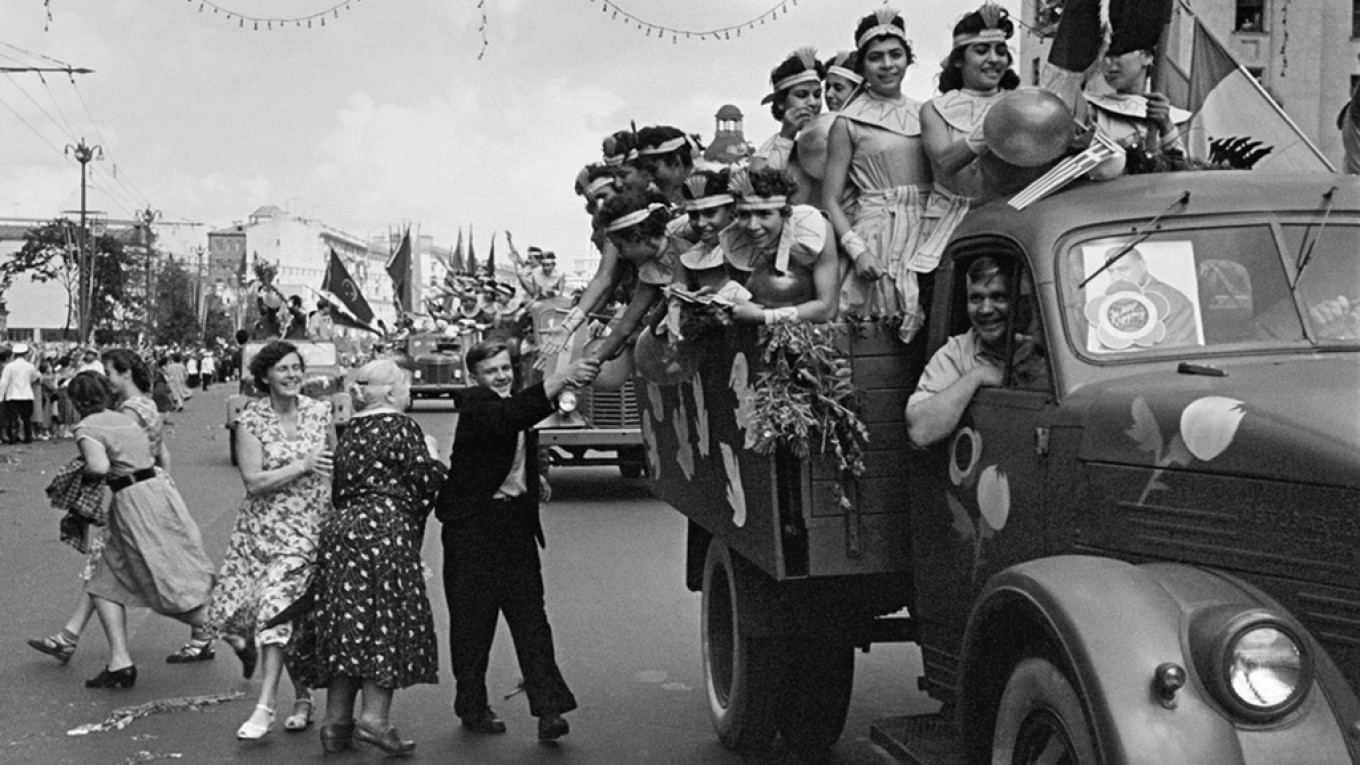Eleonory Gilburd’s “To See Paris and Die: The Soviet Lives of Western Culture,” one of the six books nominated for this year's Pushkin House Book Prize, takes a radically new look at the Thaw, a period of relative cultural freedom that dates roughly from the death of Josef Stalin in 1953 until the Soviet invasion of Czechoslovakia in 1968. This was a time when cultural controls loosened, allowing more freedom for Soviet culture and opening the doors to culture from abroad.
Gilburd studies how these Western cultural artifacts — books, music, dance, cinema, art, language, behavior — entered the Soviet Union and acquired new and different meanings. Her focus is not on how Western culture influenced Soviet culture, but actually on how Soviet culture influenced these Western arts, transforming them into something they were not before they crossed the border. “Hemingway was read not so much for his modernism as for his stoical morality, bitter merriment, and lonely courage,” she writes. “Largely overlooking Remarque’s pacifism, readers saw saving grace in love and friendship, the leitmotif of his novels. To Soviet audiences, Salinger’s Holden Caulfield was not merely an adolescent in search of himself, but a figure of universal tragedy.”
And so it was with Italian films, French impressionism, South American love songs and dances, and even clothing and hair styles. Our Picasso is not their Picasso.
This shift of focus is at first surprising and then riveting, particularly thanks to the extraordinarily wide array of source materials Gilburd cites. She uses the standard books, periodicals, films, television and documentary footage, published memoirs documents to track the work of the political and cultural mediators who brought in, translated, dubbed, curated and published works of Western culture.
But she also quotes the consumers of this culture, the people who sang, watched, danced, and read these works of art and interpreted them in their own way. Diaries, letters to editors, comments in guest books at exhibitions, club and factory lectures, and other intimate sources give not just insight, but depth and emotion. Visitors to a 1960 photography exhibition of Paris wrote paeons of love in the guestbook. “I love France, I love Paris, I love the French,” they wrote. If they had never been to France and might not ever go, it didn’t matter. They were in love with their Paris.
“’To see Paris and die,’ the Soviet version of ‘Vedi Napoli e poi muori,’ was a dream and a death wish,” Gilburd writes. “The idiom meant that Paris was the ultimate fulfillment of life’s aspirations, with nothing else left to experience.” She ends the book with an epilogue that jumps to the 1990s, when Soviets could experience the real Paris and sometimes found it a paler and far less compelling version of their dream of Paris.
Today a generation of Russians have grown up traveling to other countries, seeing undubbed films, dancing to foreign music, and wearing the same clothes as their peers in Paris, New York, or Hong Kong. Foreign culture is undoubtedly less mediated by the imagination. Gilburd has captured an era that has come and gone, at least for now.

In the second chapter of the book, "The Tower of Babel," Gilburd takes us to the Youth Festival of 1957. Over the course of many months as the event was coordinated with young communist organizations around the world, the Soviet side began to lose a grip on the propaganda project they had envisioned. But they need not have worried. In the end, their looser control produced better propaganda for the Soviet Union than anything they could have stage-managed.
On the Soviet side, the organizers included some of the people who designed the early Soviet mass physical culture and street celebrations: decorator Mikhail Ladur (1903–1976), stage artist Boris Knoblok (1903–1984), and the directors of mass spectacles Iosif Tumanov (1909–1981) and Betti Glan (1903–1992). Glan had designed Gorky Park and then was arrested in 1937 when her husband, head of the Central Committee of the Communist Party of Yugoslavia, was executed. She was released after Stalin's death and invited to work on the Youth Festival.
In the excerpt below, Gilburd describes the fantastical and truly revolutionary concepts for the event, and how some design elements were accepted by the Communist Party officials despite their initial reluctance.
***
The Festival Preparatory Committee brought Ladur and Glan, now released from the Gulag, together again. In designing the festival, their first and singularly influential references were the mass celebrations of the 1920s and the carnivals and gymnastics parades of the 1930s. From the 1920s, these people had preserved their zeal for the avant-garde art of the squares. But in the meantime, they also had acquired a love of symmetry and order, as well as a fondness for the plush curtains, papier-mâché, telling details, and historical accuracy of the realist stage. Many attractions, special effects, and carnival tricks came to the festival from the Gorky Park of the 1930s. Gorky Park had been an oasis, where “the miracles” had been confined. Festival Moscow would be a citywide Gorky Park. The artists conceived of the city as a stage, the buildings and boulevards, parks and ponds as stairs, aprons, proscenia, curtains, and cycloramas. They designed their events to match the theatrical Moscow of their sketches.
But the city itself posed a challenge. As the head of the Preparatory Committee’s program department explained, there was “a danger that the festival would be lost in such a huge city as Moscow. That is why we must give Moscow a feel for the festival.” How to make the city feel? One way of assimilating the festival in Moscow was to disperse it, and this was exactly what Ladur proposed. “Scatter the spectacle all around Moscow. Explain to the people that interesting things are not to be seen in one [specific] place, one square, but all around Moscow.” The thinking behind Ladur’s suggestion was that Soviet holidays were centripetal: for the most part, they took place in city centers, with a parade down the main street toward the seat of power, or, in Moscow, down the streets converging at Red Square. By contrast, the festival sprawled, radiating out to the train stations, to the outskirts beyond the nascent Moscow Automobile Ring Road, then to Khimki. The festival’s opening motorcade was linear, circumventing the center and connecting the opposite ends of the city, the northeast and the southwest. The procession and foreign presence spotlighted these two neighborhoods within the capital’s order of places. The delegates were housed in the environs of the All-Union Agricultural Exhibition and the Botanic Gardens in the northeast; their final destination was the new Luzhniki Stadium located in a new neighborhood, the South- West, whose construction had begun in 1952 and whose landscape was still pierced by lifting cranes. Before the festival, foreigners had been con- signed to specific places, enclaves invisible to much of the population and coded as dangerous (as well as privileged) in the Soviet press, fiction, film, and popular imagination. The festival recast the place of foreigners in Moscow. They could be found anywhere, even beyond city limits.
Iosif Tumanov and Boris Knoblok invented an even more “radical” way to domesticate the festival—by bringing it to people’s homes, in the form of manufactured decorative kits, complete with ribbons, vinyl flowers, little flags, triangular streamers, and stickers depicting the festival emblems, the daisy and the dove. A month or two before the event, the population busied itself with cutting out paper lanterns and carving plywood daisies. Crimped paper, cardboard and gauze for sturdiness, ropes and wires for hanging, paper streamers and fabrics, even white towels in place of canvas: people glued together and painted whatever they wanted and thus made the event their own. They transformed a state holiday into something of a personal celebration, much like New Year’s Eve, when the long-standing practice of devising ornamental birds, snowmen, snowflakes, and paper lanterns doubled the festive anticipation and familial togetherness. Not only the skills but even the patterns came in handy for the festival: the summer season notwithstanding, paper snowflakes embellished some windows.
The Soviet system of festivities provided the practical know-how, but the influence ended there. If there were any Soviet celebratory rituals in the event, they slipped in by habit or mistake. Festival planners repeatedly urged each other to pay attention to foreign audiences and were mindful of avoiding overtly Soviet themes. Instead, they sought universal symbols: dove, torch, fire, water, white and blue. At the opening ceremony, the “festival flag” was to be carried before national and Soviet banners. The flag was a white silk field with a daisy of five colorful petals standing for the five continents. The daisy was designed in Moscow specifically for this event, and its red, blue, green, yellow, and purple petals recalled a different ceremonial order. Its closest visual and symbolic kin were the five intertwined Olympic rings. When the Olympic Games finally took place in Moscow in 1980, some of the same people who had staged the festival, notably Iosif Tumanov, would design the opening and closing ceremonies. Torches were among the most prominent “Olympic” elements in the festival ceremonies. Thousands lit torches at the “rally against nuclear war- fare” and carried them through the streets. The grand ball in the Kremlin ended in a farewell ritual that involved torches. At midnight, Soviet hosts, torches in hand, lined up at the Spasskii Gates as foreigners disbanded. Cardboard and real torches were also part of city décor, and the torch became a second symbol of the festival: a hand raising a torch appears on festival keepsakes, on everything from glass holders to flashlights. All this, including the release of doves and the flame, had more to do with the Olympics—or with Olympian dreams—than with the structure and symbolism of Soviet celebrations.
Fire was ubiquitous in the festival theater. Invested with significance at all times and in all cultures, fire has represented passions, enlightenment, transformation, and purification. It seemed a perfect element for an event whose makers so self-consciously wished to stir lofty feelings, impart knowledge, and transform participants. At “the rally against warfare,” fire meant passion and pathos. A hand holding a torch was a declaration of activism, while rows of such hands were a statement of strength and unity. Fire was the centerpiece of “the evening of solidarity with colonial youth” in Ostankinskii Park. This production drew on another staple of fire references: elemental, primordial, sacred. A motionless pond—the counterpoint to fire—added a touch of mystery to the performance. Canoes carrying torch- bearers glided gently toward the center of the pond, where participants set afire a daisy-shaped raft, fusing flame and water. Back on the shore, a bonfire soon transformed the grounds into a place of bonding and magic. People began to move into the fire circle—to move round and round, to sing and dance and beat the djembes deep into the night. Blazing flames, rising smoke, drum rolls, “bodies and faces flushed” with excitement: years later, Knoblok recalled the scene as spellbinding, practically shamanistic. And then there was the question of how to represent Russia while striking universal recognition. Bygone Russia mattered to the artists’ conception of the festival, and it left its traces on postcards and in street ornaments, whose distinctive curly floral patterns were inspired by traditional wood paintings in black and gold. Bygone Russia also made an appearance in folk costumes and repertoire, and in celebratory sequences, which extensively relied for mise-en-scène on old Russian street fairs. The circus cavalcade was stylized as a Russian outdoor fête. Festival artists brought out show booths, market tents, street vendors hawking trifles, dancing bears, fluffy pancakes, gingerbread, and mead, and so mixed the recognizable ingredients of the Shrovetide into a mid-twentieth-century international mega-event. But “the image of Russia and her bears” was precisely what the head of the Komsomol Aleksandr Shelepin wanted the festival to dispel. Show booths, popular fêtes, and “antediluvian costumes” “à la russe” were no longer the essence of the Russian “national character.” They were a joke. The serious content was this: “We must show [Russia] as an advanced, mighty power with one of the greatest cultures that any country could envy.”
Preparatory Committee discussions about city décor were tense, coming close to a showdown between Shelepin and Ladur. Shelepin did not like the sketches that Ladur presented in the spring of 1957 for two reasons: the projects were too costly and too avant-garde. The artists envisioned a sensuous festival that would overwhelm people’s eyes and ears, even their noses, and thus reach their hearts. Think about it, Tumanov urged the Committee, and let us paint poppies and daisies on the ground, turning roads into flower fields. Shelepin, however, never tired of repeating that the festival was a very serious political matter, and Committee meetings often were disturbed by his accusations that the artists were brazenly indifferent to politics.
The artists were offering a city of excess, a city-theater, a festival-carnival. To turn Moscow into a celebratory city, Tumanov and Knoblok even resolved to repaint streetcars, buses, taxis, as well as vans, cars, and pickup trucks carrying the foreigners. For the artists, this was essential, because, in Knoblok’s words, everything bore “military color.” It was the pervasive olive and brown that ultimately broke the Preparatory Committee’s resistance to the idea of portable color. As Knoblok reported, “No argument or reason worked until the very day, or more precisely, the very morning of the motorcade rehearsal.” That morning was damp and dull; the ground was shiny black; it had rained. Hundreds of cars and trucks covered in khaki began their slow journey through the rain, as if straight from a battleground. “The sight was so dismal that no other proof was needed: everybody at once started saying how necessary repainting was!” To paint trucks and vans—from olive green to orange, blue, yellow, lilac; to paint them twice over—with exotic flowers, birds and butterflies, with wavy azure stripes. To this day, in interviews and memoirs, mention of the festival triggers recollections in color and of color: “Before, we had known no other but camouflaged trucks in Moscow, as if they all were ready for sudden mobilization, for transfer to the army regime. But at the Moscow festival there appeared trucks of different, sometimes unthinkable colors.” There was something wild about purple cars. Aesthetic and emotional abandon replaced homogeneity and solemnity.
Note: For ease of reading, the footnotes have been removed from this section.
Excerpted from TO SEE PARIS AND DIE: THE SOVIET LIVES OF WESTERN CULTURE by Eleonory Gilburd, published by Harvard University Press.
Copyright © 2018 by the President and Fellows of Harvard College. Used by permission. All rights reserved.
A Message from The Moscow Times:
Dear readers,
We are facing unprecedented challenges. Russia's Prosecutor General's Office has designated The Moscow Times as an "undesirable" organization, criminalizing our work and putting our staff at risk of prosecution. This follows our earlier unjust labeling as a "foreign agent."
These actions are direct attempts to silence independent journalism in Russia. The authorities claim our work "discredits the decisions of the Russian leadership." We see things differently: we strive to provide accurate, unbiased reporting on Russia.
We, the journalists of The Moscow Times, refuse to be silenced. But to continue our work, we need your help.
Your support, no matter how small, makes a world of difference. If you can, please support us monthly starting from just $2. It's quick to set up, and every contribution makes a significant impact.
By supporting The Moscow Times, you're defending open, independent journalism in the face of repression. Thank you for standing with us.
Remind me later.







